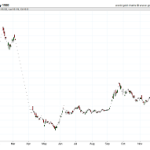The year 2020 was a rollercoaster ride for the silver market, as it experienced unprecedented fluctuations due to a combination of factors. Like a ship caught in a stormy sea, silver prices were buffeted by the pandemic and the US stock market crash, causing wild daily price swings and volatility that left investors reeling.
However, despite the turbulence, silver prices also surged to record highs in July and August, creating opportunities for savvy traders to profit from the market’s ups and downs.
This article will provide an in-depth analysis of silver prices in 2020, examining the impact of the pandemic and stock market crash on the market, as well as providing daily price data, historical trends, and charts.
Using an objective and analytical approach, we will explore the factors that caused silver prices to fluctuate so dramatically, assessing the role of supply and demand, investor sentiment, and other market forces.
As we delve into the complex world of silver trading, we will also examine the London Bullion Market Association (LBMA) Silver Price Auction and composite prices from various trading banks and brokerages, as well as providing information on forex silver markets and trading hours.
Overview of 2020 Prices
The year 2020 proved to be a tumultuous one for the silver market, with daily fluctuations ranging from a low of $12.97 on March 16, 2020, to a high of $28.33 on August 18, 2020, amidst the global pandemic and the US stock market crash.
Various factors affected silver prices in 2020, including the unprecedented demand for safe-haven assets, the declining value of the US dollar, and low-interest rates. Historical trends in silver prices also played an essential role in the market’s fluctuations, with silver prices often rising during times of economic uncertainty and inflation.
The pandemic’s impact on the global economy led to bullion shortages, which also affected silver prices. Many investors turned to precious metals such as silver as a safe-haven asset, leading to an increase in demand and prices.
However, the US stock market crash in February 2020 had a significant impact on silver prices, with all asset classes melting down in fiat price denominations. The market’s reaction to the pandemic and the stock market crash led to a highly volatile silver market in 2020, with prices fluctuating throughout the year.
Impact of Pandemic and Crash
Due to global events in 2020, the precious metal market experienced a decline in value, with a particularly notable decrease observed in March, when the market dropped by over 20%. The pandemic led to a significant impact on the silver market trends, as global supply chain disruptions caused a shortage in silver bullion, leading to fluctuating prices. Additionally, the US stock market crash in February 2020 also played a role in the decline of silver prices.
The pandemic caused a disruption in the worldwide supply chain, leading to a shortage of silver bullion. As a result, investors turned to other forms of investment, leading to a decline in silver prices. However, the market later rebounded, with a significant increase observed in July and August 2020, reaching a high of $28.33 on August 18, 2020. Overall, the pandemic and the subsequent disruption in the global supply chain had a significant impact on the silver market, leading to fluctuating prices throughout the year.
Daily Prices August-December
From August to December 2020, the daily price data for silver displayed significant variability. After reaching a high of $28.33 per ounce on August 18, 2020, silver prices fluctuated throughout the remainder of the year.
The lowest daily price during this period was $22.15 per ounce on September 24, 2020, while the highest was $26.82 per ounce on December 1, 2020. These fluctuations were largely driven by a supply shortage and a surge in demand for physical silver, which was fueled by uncertainty surrounding the COVID-19 pandemic and the global economy.
Several factors affected silver prices during this period. One of the main drivers was the ongoing pandemic and its impact on the global economy. As investors sought safe-haven assets, demand for precious metals like silver increased. Additionally, disruptions in the global supply chain led to shortages of physical silver, which further contributed to price volatility.
Other factors that influenced silver prices included changes in the US dollar exchange rate, geopolitical tensions, and fluctuations in the stock market.
Overall, the daily price data for silver in the second half of 2020 reflected a complex and dynamic market, with multiple factors influencing supply and demand.
LBMA and Composite Prices
Concerning LBMA and composite prices, the silver market relies on various trading banks and brokerages to establish a composite price for over-the-counter Silver Bullion trading. The LBMA Silver Price Auction is a widely recognized benchmark price for the global silver market and is determined daily by a panel of participating banks. The composite prices reflect the average of the bid and ask prices from various trading banks and brokerages in the over-the-counter Silver Bullion markets. These prices are widely quoted in the precious metals industry and are used by investors to make informed decisions about buying and selling silver.
Market analysis suggests that the impact of the pandemic on the silver market will continue to be felt in the coming months. The ongoing bullion shortages and fluctuating prices are expected to persist due to the uncertainty surrounding the pandemic and its economic effects. However, some experts predict that the demand for silver will increase as the global economy begins to recover, which could lead to higher prices. It is important to note that there are many factors that can affect the price of silver, and predictions for future prices should be taken with caution. Investors should carefully consider all available information and consult with a financial advisor before making any investment decisions.
Frequently Asked Questions
What factors outside of the pandemic and stock market crash impacted silver prices in 2020?
Mining production and industrial demand were key factors that impacted silver prices in 2020. Supply disruptions due to COVID-19 related lockdowns and reduced mining output led to a decrease in silver supply, while increased demand for silver in industrial applications resulted in higher prices.
How do silver prices compare to other precious metals like gold and platinum in 2020?
When considering investment strategies, it is important to compare the performance of different precious metals. In 2020, silver and platinum had varying price fluctuations, with silver outperforming platinum. However, individual investment goals and risk tolerance should always be considered.
What role do government policies and regulations play in the fluctuation of silver prices?
Government policies and regulations can have a significant impact on the silver market, particularly through interventions in currency and interest rates. However, accusations of market manipulation by governments and other entities have also been raised.
How do global events and geopolitical tensions affect the silver market?
Geopolitical tensions and supply and demand dynamics play a significant role in the silver market. Fluctuations in global economies and political unrest affect silver prices, while demand from industries like electronics and solar power impact supply.
What long-term trends can be observed in the silver market over the past decade?
Long-term trend analysis of the silver market reveals fluctuations in industrial demand and mining production. The 2010s saw periods of growth and decline, with a peak in 2011 followed by a downward trend. Factors like economic uncertainty, currency fluctuations, and geopolitical tensions continue to impact the market.





